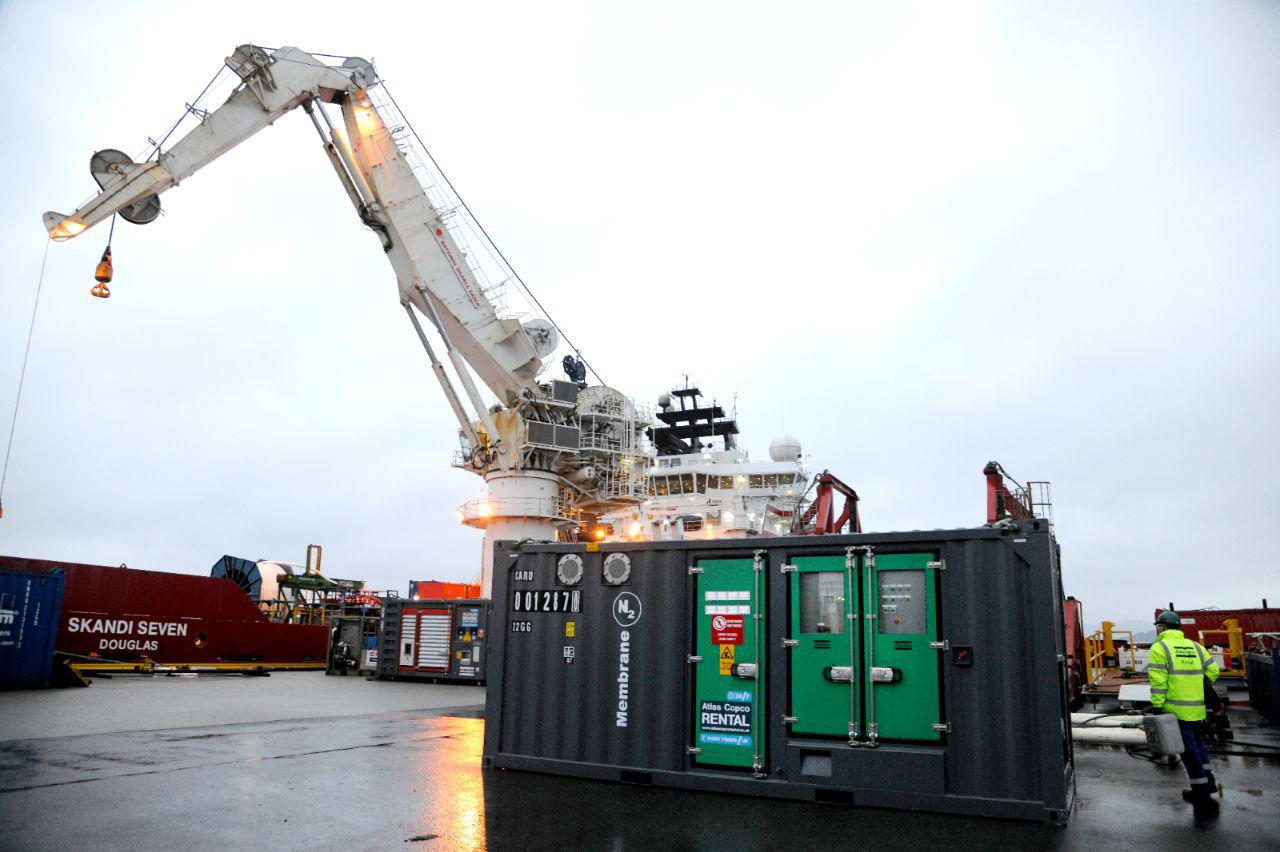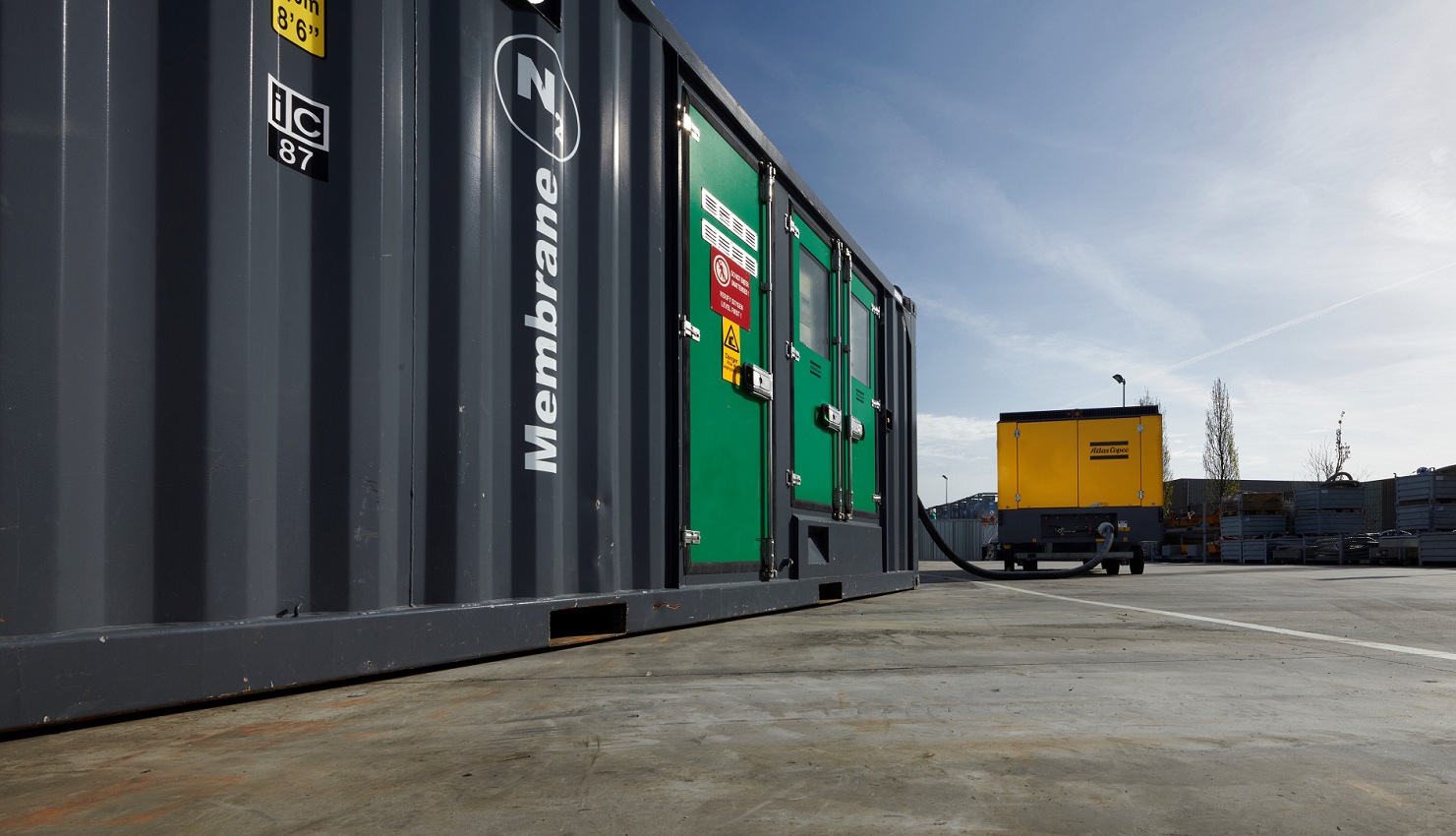Our Nitrogen units provide a continuous, reliable flow of nitrogen with flow and purity rates adjustable to your exact requirements. Our nitrogen membrane fleet ranges from 95% to +99% purity, with flow rates up to 3000 cfm.
High and pure

What is nitrogen?
Did you know the air around us is mostly nitrogen? Everyone needs oxygen to survive. However, the air we breathe is made up of 78% nitrogen, only a mere 21% oxygen and tiny amounts of other gases. The human body does not use this nitrogen, it is however very helpful in various industrial applications.
Let’s start with the basics. Nitrogen is an inert gas that is odorless, colorless, and does not sustain life. However, it is important for plant growth and is a key additive in fertilizers. Its usage ranges far beyond your garden. Nitrogen usually appears in either liquid or gas form (although it is possible to attain solid nitrogen as well). Liquid nitrogen is used as a refrigerant, which is able to rapidly freeze foods and subjects in medical research, as well as reproductive technology. For the purpose of this explanation, we will stick with nitrogen gas.
Nitrogen is widely used, mainly, due to the fact that it does not react when exposed to other gas, unlike oxygen, which is very reactive. Due to its chemical composition, nitrogen atoms need more energy to be broken and react with other substances. Oxygen molecules on the other hand are easier to break apart, therefore, making the gas much more reactive. Nitrogen gas is the opposite, providing unreactive environments where needed.
The lack of reactivity of nitrogen is its biggest quality and as a result, the gas is used to prevent slow and fast oxidation. The electronics industry presents a perfect example of this use, as, during the production of circuit boards and other small components, slow oxidation can occur in the form of corrosion.
Slow oxidation is also no stranger to the food and beverage industry, wherein this case, nitrogen is used to displace or replace the air in order to better preserve the end product. Explosions and fires are a good example of fast oxidation since they need to be fueled by oxygen. Removing the oxygen from a vessel with the help of nitrogen reduces the likelihood of these accidents from occurring.

Temporary nitrogen solutions
If you require a temporary supply of nitrogen, renting equipment and generating your own nitrogen onsite using compressed air, is ideal. It allows for full quantity, pressure, and purity control for the given application.
There are two types of nitrogen generators in our fleet:
Membrane Nitrogen Generators
Pressure Swing Adsorption Nitrogen Generators
Because Atlas Copco Rental doesn’t only offer Total Solutions on land, we have Nitrogen generators suited for Offshore applications. Same quality and reliability, but additional safety features to handle life at sea. Limited footprint? No problem. We even have Membrane Nitrogen Generators and Compressor integrated into a 20ft container with DVN 2.7-1 approved lifting frame.

How does membrane technology work?
Membrane nitrogen generators are based on a simple working principle. The main part of a membrane generator is the membrane module (+- 10cm in diameter), filled with small, hollow polymer fibers. First, dry, clean compressed air enters and due to the structure of these fibers, parts of the air will flow to the outside of the fiber. This process is called permeation. During this process, water, oxygen and some of the argon exit through the membrane sides of the fibers. In the end, only nitrogen will remain. This is possible since different molecules permeate at different speeds.
H2O will permeate very quickly, oxygen takes a little longer. Argon and Nitrogen permeate rather slowly, meaning that they will remain in the fibers long after the H2O and oxygen are gone (some of the Argon will permeate as well, but it would be inefficient to completely remove it from the air stream). Because of the permeation through the fiber wall, an overpressure would occur inside the membrane housing. The fibers would clog and the permeation efficiency would be significantly lowered. To prevent that from happening there is an opening in the housing, the permeate vent, where these ‘exhaust’ gases (including H2O, oxygen and Argon) can escape.

“Long or short-term. We supply on-site N2 solutions according to your terms.”
– Elizabeth Hall, Sales Engineer
How does Pressure Swing Adsorption work?
When producing your own nitrogen, it is important to know and understand the purity level you want to achieve. Some applications require low purity levels (between 90 and 99%), such as tire inflation and fire prevention, while others, such as applications in the food and beverage industry or plastic molding, require high levels (from 97 to 99.999%). In these cases PSA technology is the ideal and easiest way to go. In essence, a nitrogen generator works by separating nitrogen molecules from the oxygen molecules within the compressed air. Pressure Swing Adsorption does this by trapping oxygen from the compressed air stream using adsorption.
Adsorption takes place when molecules bind themselves to an adsorbent, in this case the oxygen molecules attach to a carbon molecular sieve (CMS). This happens in two separate pressure vessels, each filled with a CMS, that switch between the separation process and the regeneration process. For the time being, let us call them tower A and tower B. For starters, clean and dry compressed air enters tower A and since oxygen molecules are smaller than nitrogen molecules, they will enter the pores of the carbon sieve. Nitrogen molecules on the other hand cannot fit into the pores so they will bypass the carbon molecular sieve. As a result, you end up with nitrogen of desired purity.
This phase is called the adsorption or separation phase. It does not stop there however. Most of the nitrogen produced in tower A exits the system (ready for direct use or storage), while a small portion of the generated nitrogen is flown into tower B in the opposite direction (from top to bottom). This flow is required to push out the oxygen that was captured in the previous adsorption phase of tower B. By releasing the pressure in tower B, the carbon molecular sieves lose their ability to hold the oxygen molecules. They will detach from the sieves and get carried away through the exhaust by the small nitrogen flow coming from tower A. By doing that the system makes room for new oxygen molecules to attach to the sieves in a next adsorption phase. We call this process of ‘cleaning’ an oxygen saturated tower regeneration.